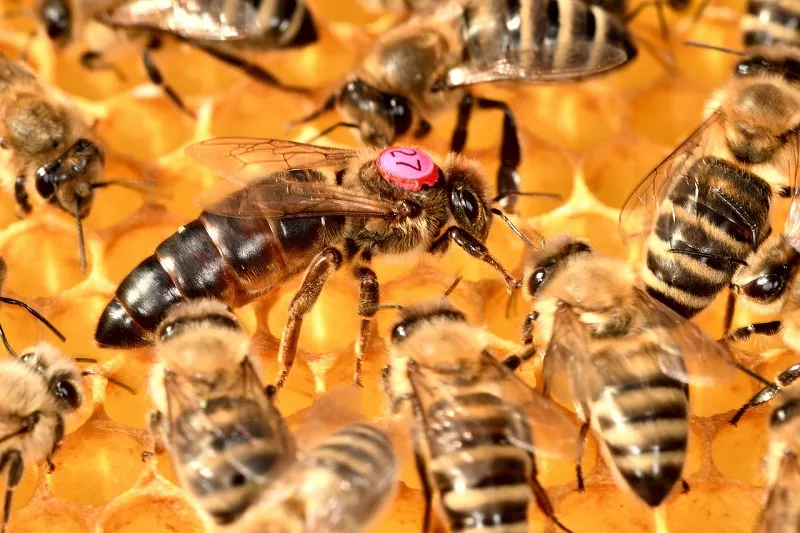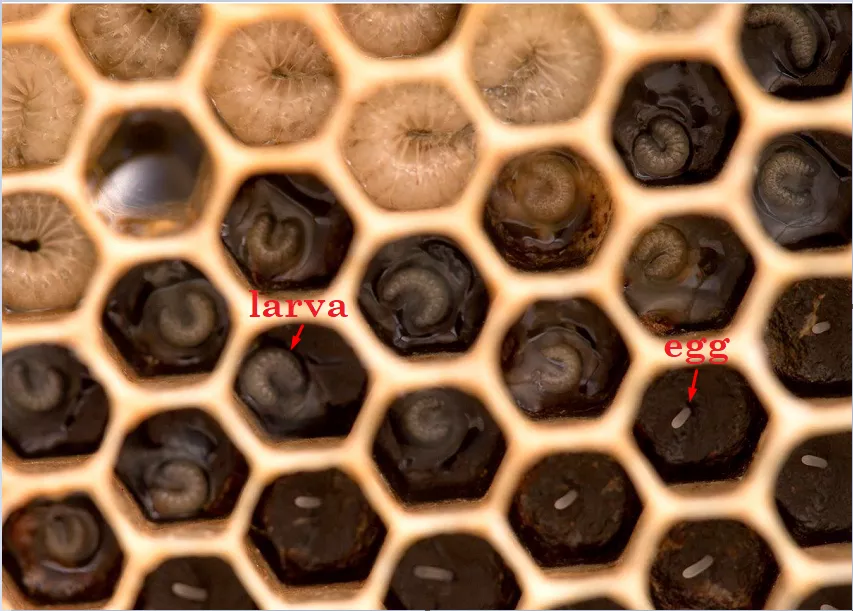When I first started beekeeping, I knew the queen bee was responsible for laying eggs and keeping the worker bees alive. But I don’t know how long it takes for the queen bee to start laying eggs after I put it in the hive. Egg-laying is no small feat, and the faster the queen starts laying eggs, the better for your colony. Whether it’s a queen you’ve added yourself or a newly hatched queen.

How Long Does It Take For A Queen Bee To Start Laying Eggs?
Newly installed queen bee can take up to 7 days. For a newly hatched queen, it should take about 2-3 weeks.
Three different conditions affect how quickly a queen bee begins to lay eggs. These are:
- The queen has just been added to the hive,
- A newly hatched queen,
- The bee colony has swarmed or split
Each situation has its own unique factors and risks. Read on for more information on all of this.
When The Newly Added Queens Should Start Laying Eggs?
After placing bees in a hive, it can understandably take a few days for them to settle in and feel comfortable in their new home. When a pack of bees arrives, the queen bee is placed in a small cage, separating her from the colony, allowing you to find her quickly and giving the colony time to accept her.
During installation, the cage has a candy plug at one end to keep the queen bee inside and should be attached to the frame inside the hive. After the rest of the bees are installed, they take up to a week to chew through the candy plugs that allow them to release the queen. During this time, the bees will get used to the smell of the queen and will accept the queen more easily.
She may start laying eggs immediately after being released from the cage as she is likely to have mated, but it may take another 7 days for her to settle down at home after being released so that she can cope with egg laying can begin.
When The Newly Hatched Queen Should Start Laying Eggs?
Hatching a new queen bee is a very precise process that requires quick thinking from the worker bee. A colony spawns a queen when the hive is being prepared for a colony or is divided and the queen is taken away, or when her queen dies. Workers caring for eggs and larvae have only about 3 days to decide to turn worker bee larvae become queen bee larvae.
A queen bee is created when the queen bee lays her eggs into a specially prepared cell by the worker bees, which widens the cell walls to accommodate a larger cell.
The newly hatched larvae are then fed only royal jelly to mature into sexually mature females.
The expanded cells of future queen bees were then sealed for worker bees and drones on day 8 instead of day 9 or 10, respectively.
If all conditions are perfect, when a queen bee hatches, she will start the mating flight after 2-4 days, and she will need another 6-8 days to start laying eggs.
It can take up to 3 weeks for a new queen to hatch, mature, mate and start laying eggs, and a variety of factors can affect this timeline, including fluctuations in the number of days to sexual maturity or weather delays for queen mating flights.

When Do Queens Start Laying Eggs After Swarming Or Splitting The Hive?
Hives swarm when a bee colony becomes too large to hold the hive and they need more space. This allows bees to reproduce at the colony level, as swarming ends up producing two colonies where there was one colony before.
To prepare for their split, the hive will create a queen, which will hatch shortly after leaving the existing bees. A queen leaves the hive with just over half the colony in search of new settlements. This is a pretty amazing example of pre-planning and preparation, don’t you think?
After swarming, the queen begins laying eggs almost immediately to ensure her hive recovers and thrives in its new environment.
Some beekeepers who notice signs of an impending swarm — an increase in queen eggs or overcrowding — can often divide their hives before it happens. They do this by moving half of the hive into a new hive box, essentially creating two hives from one. When they share a hive, one hive has the advantage that the queen starts laying eggs almost immediately, while the other has to wait for the new queen to hatch and start laying eggs.
Dividing hives or placing colonies in hive boxes is ideal when you want to increase the size of your apiary. This is the most cost-effective because you don’t have to buy a new bee pack every time you want to form a new bee colony.
Dangers That Exist For The Queen And The Beehive
The queen bee has a tough time, especially at the beginning. There are several risks:
- If the hive isn’t ready to install a new queen, or isn’t used to her scent during the time they chew the sugar plug, they may kill her. Without the queen bee laying new eggs every day, the hive may become weak and the colony cannot survive
- When multiple queens hatch at the same time, they fight, only the most powerful queen survives, destroying other queen bees to take control of the hive
- During her mating flight, bad weather conditions and hungry birds could kill the queen bee before the mating process begins.
Mating Flight Of Queen Bees
Before queen bees can start laying eggs, they must complete their mating flight. The queen bee usually mates only once in her life and stores her sperm for the fertilization of all her eggs in the future.
If the queen doesn’t collect enough sperm on her first mating flight, she may need to make another one, but the goal is to only leave the hive once during the first mating flight, and possibly a second time if the hive is swarmed.
During the mating flight, the queen leaves the hive, escorted by worker bees, and encounters a drone staging area 20 feet above the ground, where thousands of drones are looking for a queen to mate with.
The queen mates with a dozen or more drones and returns to the hive to perform duties of maintaining the hive population.
How Do You Know If The Queen Is Laying Eggs?
A hive inspection is essential to ensure that the queen bee is laying eggs. Once you’ve dressed and took a Bee smoker, removed a few frames, it’s time to hunt for eggs.
Eggs are smaller than a grain of rice, but about the same shape and color. They’re hard to spot, but as soon as you see them, you know the queen is alive. I tried looking for eggs with a magnifying glass. This might make the process a little easier until you’re used to what you’re looking for and can quickly spot them with the naked eye.
You should also look for larvae to ensure the eggs are cared for and grow into worker bees and drones to replace those that die or are killed in service.
Eggs take about 3 weeks to hatch and develop into adult bees, but the length of time depends on the type of bee that is developing. While this is an exciting time, patience is the key.
For the most part, bees know what they’re doing and can be left to their own equipment most of the time, but it’s best to drop by them so you can get to know each colony and quickly determine if there’s a problem.
Related Questions:
How Many Eggs Does The Queen Bee Lay In A Day?
Because it only takes seconds to lay eggs, a single queen bee can lay as many as 2,000 eggs per day.
How Long Can A Queen Bee Live?
The queen bee can live for several years under ideal conditions, but she faces dangers that shorten her lifespan considerably.
How Many Bees Form A Colony?
Colonies vary widely in size, from 20,000 to over 80,000. Each colony consists primarily of worker bees, several hundred drones, and a queen bee, as well as any developing eggs and larvae.
How Long Can Drones Live?
Drones are male bees born from unfertilized eggs, live about 8 weeks, and usually die after completing their mating task.
How Long Do Worker Bees Live?
Worker bees, sterile females, can live 4-6 weeks in the summer, but those born in the fall can live for more than 5 months.
Read more: How Long Can Bees Stay In A Nuc?
Read more: How to Know When to Add a Second Honey Super Or Brood Box?
Read more: Is Harvesting Honey Bad For Bees?